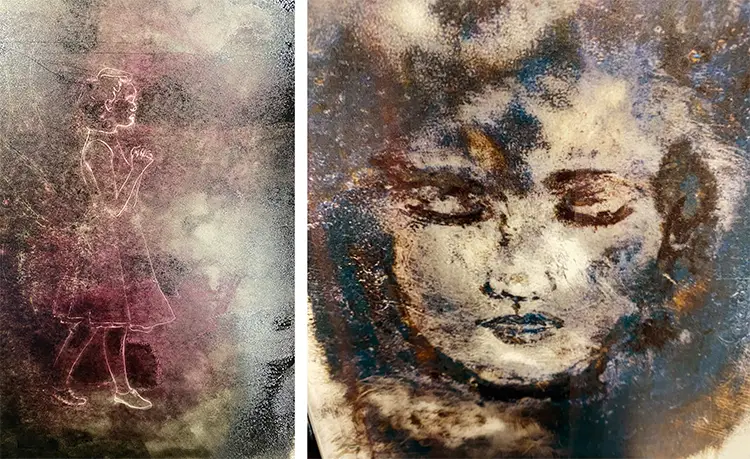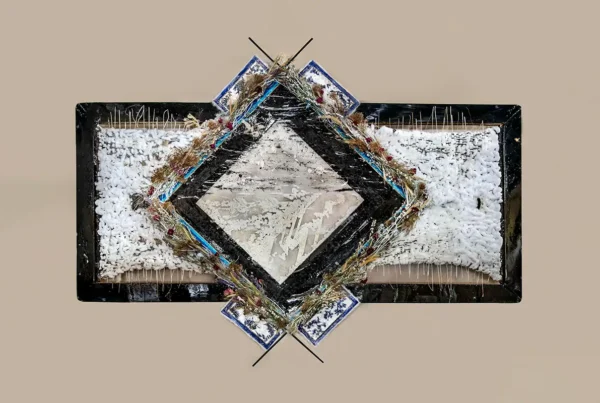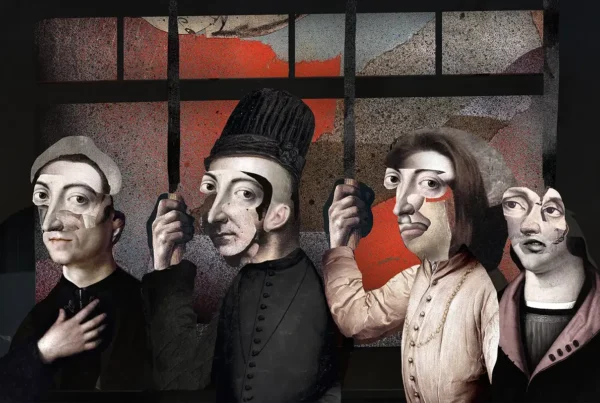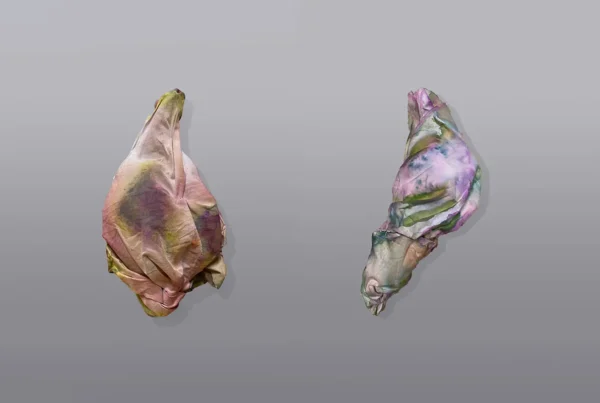Banner image: Andréanne Oberson, Ah! It’s You, Again!, performance, Church St-Antoine, Bern, Switzerland, 2019.
Photo credit: Andrea Thüler
“For me, teaching and creating are not two separate spheres. They nourish one another and find their connection in listening, emotion, and the ability to bring something essential to light.”
A Life Woven Through Creation
Andréanne Oberson’s journey as an artist does not follow the arc of a conventional career choice—it emerges as an inherent way of existing. Born in Switzerland, where she continues to live and create, Oberson’s relationship with art began long before formal education. From her earliest memories, the act of making was indistinguishable from the act of being. Whether molding garden clay into imagined landscapes or crafting stories for the small stones she kept in her pocket, her childhood was steeped in intuitive invention. Oberson found freedom in the simplest materials—colored pencils, discarded paper, and images clipped from everyday life. This formative experience cultivated an early understanding of creativity as both a refuge and a powerful means of expression.
Her artistic awakening sharpened through a significant personal event: an injury during adolescence that abruptly ended her sports activities. This pivotal moment redirected her toward an optional drawing course, where an inspiring teacher introduced her to the expansive world of contemporary art and painting. What began as a substitution for physical activity soon revealed itself as a profound calling. Oberson’s move from the rural countryside to the urban environment during her studies exposed her to the vibrant visual culture of city life, especially the striking graphic designs that adorned public spaces. Initially captivated by the work of Swiss designers like Werner Jeker, she imagined a future in graphic design. Yet, when faced with academic obstacles, including an unsuccessful first attempt at art school admission, she persisted. Her determination ultimately led her to the École cantonale d’art de Lausanne (ECAL), where she embraced visual arts over design, a choice that would decisively shape her creative path.
At ECAL, Oberson’s exploration expanded across an impressive range of mediums and methodologies. Her academic projects reflected this curiosity, notably her bachelor’s thesis—a pioneering immersive installation that merged CGI projections, interactive soundscapes, and narrative text within a fully enclosed space. This work invited viewers to engage physically with the piece, their movements subtly altering its sensory environment. Conceived in the late 1990s, when such interactive installations were still rare, the project underscored Oberson’s instinct to question and redefine artistic boundaries. This ethos of experimentation continues to inform her multifaceted practice, where each medium operates as a deliberate choice, a language in service of intention.

Andréanne Oberson, from the serie Human After Too, detail, collage, 2024, Switzerland
Andréanne Oberson: Narratives Unearthed from the Everyday
Central to Andréanne Oberson’s artistic practice is a profound engagement with the ordinary, a fascination with everyday spaces and objects as vessels of latent narratives. She approaches daily life not merely as backdrop but as a reservoir of memory and meaning, a place where overlooked fragments can be gathered, transformed, and given voice. Her work navigates the tension between presence and absence, often exploring what remains unsaid or unseen within familiar surroundings. Through acts of erasure, reconstruction, and poetic disruption, Oberson reclaims these elements, subverting conventional hierarchies of language and perception.
A striking example of this thematic pursuit is found in her project titled 306, initiated in 2017 within the walls of a roadside hotel room in northern Italy. Room 306, a transient space intended for rest or fleeting encounters, became the stage for a layered intervention. Oberson selected eighteen books to inhabit the room’s walls, focusing on the pages numbered 306—yet she erased nearly all the text, leaving only punctuation intact. This deliberate fragmentation dismantled the linearity of narrative, invoking both the rhythm and rupture of language itself. Inspired by the cut-up techniques of William S. Burroughs and Brion Gysin, her approach yields unstable, poetic fragments that resist fixed meaning, inviting viewers to confront absence as a generative force.
Throughout her projects, Oberson challenges the notion of language as an immutable structure. She seeks to fracture its coherence, to unbind its flow, and in doing so, to question the very foundations of storytelling. In her eyes, to destroy the book is to open the possibility for new forms of speech—forms that emerge from silence, from the void left by erasure. This conceptual dismantling is not nihilistic but rather transformative. By rethinking the origins of expression, Oberson crafts spaces where memory, time, and narrative are no longer linear constructs but fluid, shifting territories. Her art consistently asks: What remains when words are stripped away? What stories surface when memory is held between presence and loss?
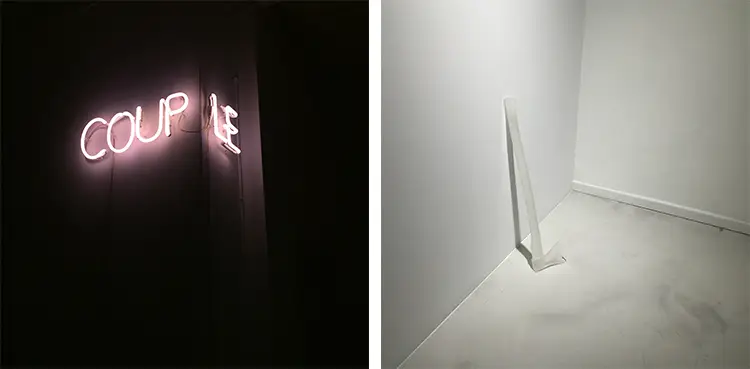
Andréanne Oberson (coll. indigène), Couple, pink neon, 22 x 92 cm, 2015, private collection, Lugano, Switzerland
Andréanne Oberson (coll. indigène), A, glass paste axe, 5 x 90 x 16 cm, 2015, private collection, Nantes, France
Resonance Through Objects and Space
Objects, particularly those marked by time and use, hold a central place in Andréanne Oberson’s creative process. Her studio, once filled with flea market finds—worn books, faded photographs, tarnished mirrors—served as both a sanctuary and an archive of forgotten voices. These artifacts, imbued with silent histories, became interlocutors in her work, their material presence echoing the past while inviting reinterpretation. Among these objects, her Polaroid SX-70 camera stands out as a faithful companion, bridging memory and immediacy. This camera became instrumental in her Elsewhere series, a body of metaphotographic work that revisits and reimagines old family photographs through deliberate reframing and the soft blur of rephotography.
Elsewhere, recognized with the Artprize CBM award and showcased at the London Art Fair in 2017–2018, exemplifies Oberson’s engagement with the spectral quality of images. In this series, the faces captured in vintage albums dissolve into vagueness, their identities obscured yet hauntingly present. Through this process, Oberson shifts focus from the literal image to its atmospheric residue—those traces that linger at the edge of recognition. The blurred photographs disrupt the expectation of clarity, instead proposing a space where memory floats untethered, echoing her broader inquiries into perception and narrative.
While Oberson’s practice once thrived within a spacious, object-filled studio, recent life changes required her to downsize and adapt her creative environment. Forced to part with many of her cherished tools and artifacts—including the presence of her studio cat—she faced what she describes as a process of mourning. Yet, these constraints did not diminish her creative drive; instead, they fostered new forms of experimentation. Her workspace evolved into a more mobile and flexible site of making, where even large-scale canvases find their place through inventive solutions. Despite the physical limitations, her studio remains a haven of focused attention, a place where distractions fall away and artistic exploration continues with undeterred passion.
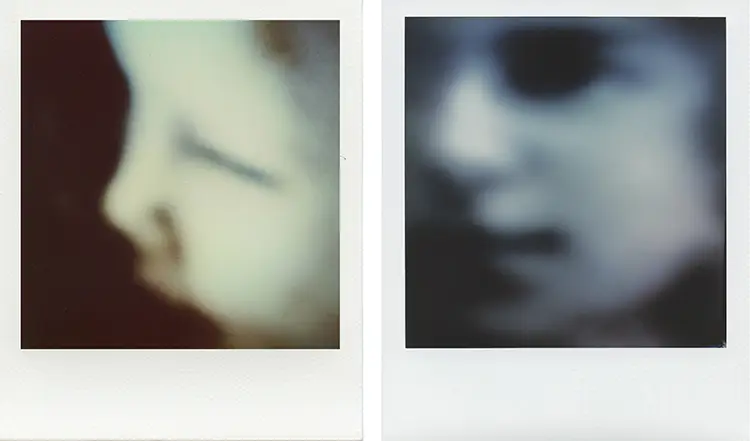
Andréanne Oberson, from the series Elsewhere, each 8.8 x 10 cm, Polaroid SX-70, 2017, Ares Contemporary Gallery, Lugano, Switzerland
Andréanne Oberson: The Alchemy of Transformation
Transformation, both bodily and metaphorical of life, lies at the heart of Andréanne Oberson’s artistic vision. Her influences reflect this preoccupation, drawing from avant-garde movements like Dada and Surrealism, the narrative fragmentation of William S. Burroughs, and the unsettling cinematic language of David Lynch. Echoes of Rebecca Horn’s mechanical extensions and Matthew Barney’s mythological narratives resonate through her work, as does the ethereal, immersive approach of Pipilotti Rist and the speculative sensibilities of Anicka Yi. Yet, it is perhaps the writings of Wassily Kandinsky, particularly Concerning the Spiritual in Art, that most intimately align with her pursuit of art as a conduit for the unseen, the intuitive, the inexpressible.
One of the most emblematic manifestations of this approach is her performance piece Ah! C’est encore toi!, staged in the attic of St. Anthony’s Church in Bern. This space, poised between sky and earth and illuminated by a glass roof, became the site of an introspective ritual. There, Oberson engaged in a meditative act of drawing ephemeral shapes with salt upon suspended glass tiles, inspired by Gustave Flaubert’s The Temptation of Saint Anthony. Each gesture formed a transient pattern that was then gently swept away, only to give rise to another. This cyclical act of creation and erasure spoke of vulnerability, healing, and the passage between visible and invisible states. The interplay of salt, light, and glass summoned a quiet yet powerful dialogue between matter and spirit, offering a poetic metaphor for inner transformation.
Beyond performance, her affinity for fluid mediums like watercolor and ink underscores this embrace of unpredictability and flow. These materials, with their capacity for transparency and surprise, mirror Oberson’s own artistic philosophy: to remain receptive to chance, to navigate between control and surrender. Water imposes its own rhythm, compelling the artist to wait, to observe, to respond rather than impose. This delicate balance between intentionality and accident allows her to cultivate works that resonate with emotional depth and openness.
Throughout her evolving practice, Oberson remains guided by a desire to foster connection—between artist and viewer, between language and silence, between body and space. Whether through sculpture, photography, performance, or publication, her work insists on the potency of listening and the necessity of transformation. Even in her dreams of a future project—a book intertwining poems and images to explore love and healing—this impulse persists. For Andréanne Oberson, art is not merely the act of creation but a profound journey into the spaces where words fail and resonance begins.
